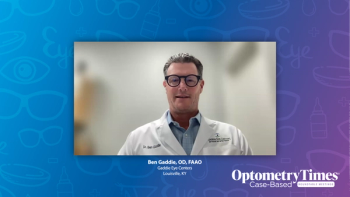
Patient Case 2: Demodex Blepharitis and Holistic Ocular Surface Relief
Ben Gaddie, OD, FAAO presents the second patient case of a 66-year-old white female with eye dryness and irritation. Though she was not previously treated for demodex blepharitis, he demonstrates how it was the root cause of many symptoms she experienced.
Summary
In the second case presented by Ben Gaddie, OD, FAAO, a 66-year-old white female with eye dryness is discussed. Despite previous treatments such as cyclosporine, tea tree oil-containing lip wipes, and LipiFlow®, the patient's condition persists with a SPEED score of 21/28, indicating significant symptoms. He raises the question of whether patients like these, who are managed for dry eye and ocular surface issues, might actually have a demodex blepharitis infestation. Tailoring treatment to the root cause, Gaddie explains, will help alleviate other symptoms she experiences.
The patient's examination reveals substantial collarets and vascularization on both upper lids. After four weeks, the patient experiences symptom improvement, regains the ability to wear contact lenses, and achieves 20/20 visual acuity. The SPEED score decreases from 21 to 10, which signals significant progress. However, persistent punctate keratitis prompts a switch to a semi-fluorinated alkane after three months, resolving corneal staining in both eyes. Gaddie emphasizes the need for follow-up appointments to monitor hair regrowth and adjust treatment plans accordingly. This case underscores the potential effectiveness of addressing demodex infestation in patients with persistent ocular surface symptoms and highlights how regular follow-ups aid in revealing ocular surface issues as they arise.
This summary was AI-generated and edited for clarity.
Newsletter
Want more insights like this? Subscribe to Optometry Times and get clinical pearls and practice tips delivered straight to your inbox.












































.png)


